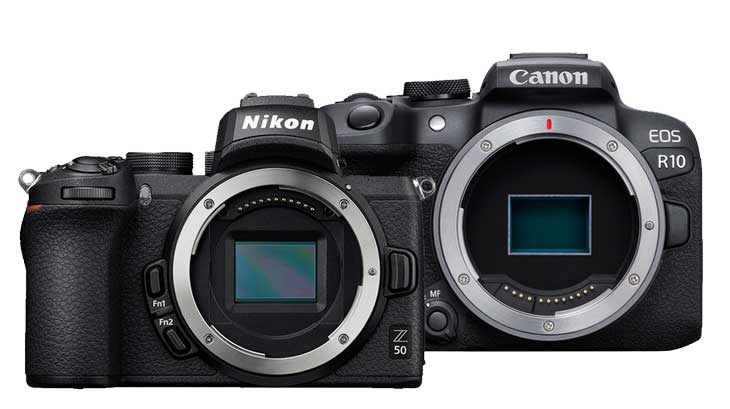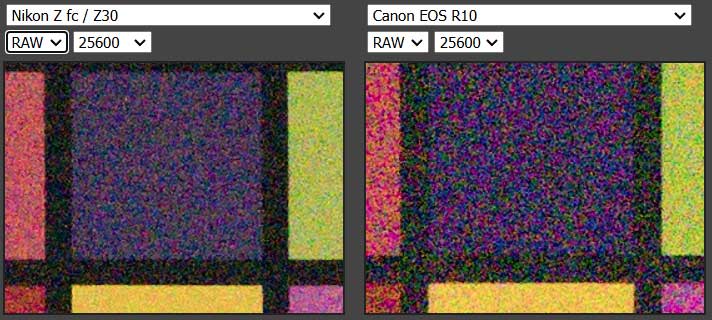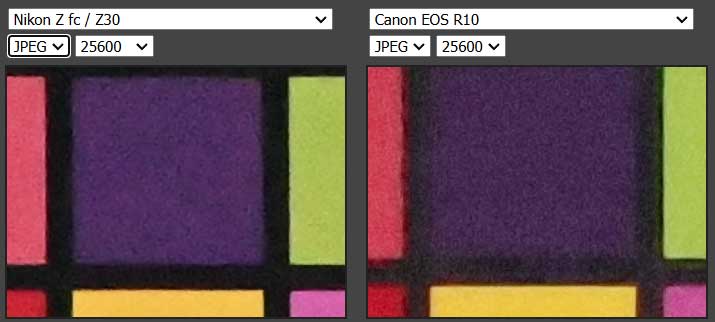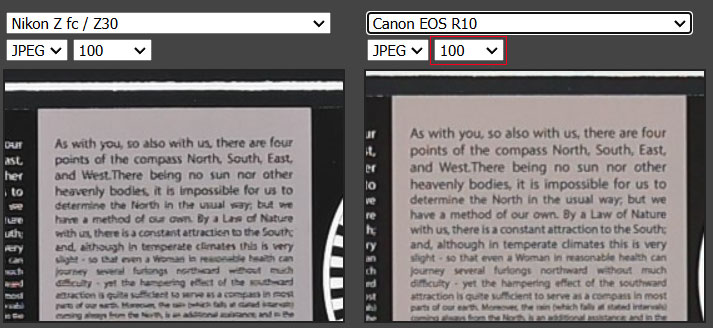
Let us compare the Nikon Z50 II with the Canon R10 camera. Let’s explore the main differences between these two cameras and find out which one is the best for photographers and which one is best for shooting videos. In the comparison table below, we have highlighted the differences in design, and we have created two separate tables dedicated to photography and videography features. So let’s find out the best camera between these two for your specific needs and budget.
1. Design Comparison
| Feature | Nikon Z50 II | Canon R10 |
|---|---|---|
| Body Dimensions | 5 x 3.8 x 2.6″ / 127 x 96.8 x 66.5 mm | 4.8 x 3.5 x 3.3″ / 122.5 x 87.8 x 83.4 mm |
| Weight | 495 g (Body Only) | 382.2 g (Body Only) |
| Lens Mount | Nikon Z | Canon RF |
| Display | 3.2″ Tilting Touchscreen LCD, 1,040,000 Dot | 3.0″ Free-Angle Tilting Touchscreen LCD, 1,040,000 Dot |
| EVF Type | Built-In Electronic (OLED), 0.39″, 2,360,000 Dot – 1000 NITS Brightness | Built-In Electronic (OLED), 2,360,000 Dot |
| Battery Type | EN-EL25a or EN-EL25, approx. 230 shots | LP-E17, approx. 430 shots |
| Ports | USB-C Data & Power, Micro-HDMI, Mic & Headphone Jacks | USB-C, Micro-HDMI, Mic Jack |
| Available Lenses | Nikon Z DX and FX lenses | Canon RF-S and RF lenses |
2. Photographic Feature Comparison
| Feature | Nikon Z50 II | Canon R10 |
|---|---|---|
| Sensor Type |
BSI CMOS | FSI CMOS |
| Sensor Size | 23.5 x 15.7 mm (APS-C) | 22.3 x 14.9 mm (APS-C) |
| Effective Resolution | 20.9 Megapixel | 24.2 Megapixel |
| ISO Range (Photo) | 100 to 51,200 (Extended: 100 to 204,800) | 100 to 32,000 (Extended: 100 to 51,200) |
| Shutter Type | Mechanical Focal Plane, Electronic Rolling | Mechanical, Electronic Rolling |
| Shutter Speed (Mechanical) | 1/4000 to 900 sec | 1/4000 to 30 sec |
| Bulb Mode | Yes | Yes |
| Continuous Shooting (Mech) | Up to 11 fps at 20.9 MP | Up to 15 fps at 24.2 MP |
| Continuous Shooting (Elec) | Up to 30 fps at 20.9 MP (JPEG) | Up to 23 fps at 24.2 MP |
| Pre-Capture Mode |
1 Sec | 0.5 Sec |
| Autofocus Points | 231 (Phase & Contrast Detection) | 651 (Phase Detection Zones) |
| AF Sensitivity | -9 to +19 EV | -4 to +20 EV |
| AF Modes | Continuous-Servo AF, Full-Time AF, Manual, Single-Servo AF | Continuous-Servo AF, Manual, Single-Servo AF |
| Weather sealed |
Yes | No |
| Battery Life |
250 Shots | 450 Shots |
3. Video Comparison
| Feature | Nikon Z50 II | Canon R10 |
|---|---|---|
| Sensor Type | BSI CMOS | FSI CMOS |
| Video Resolution & Frame Rates | UHD 4K (30 fps) Uncropped | UHD 4K (30 fps) Uncropped |
| 4k 60 FPS |
1.5X Cropped | 1.5x Cropped |
| Full HD Max Frame rate |
120 FPS | 100 FPS |
| Product showcase mode |
Yes | No |
| Video Stabilization | Digital (Video Only) | Digital (Video Only) |
| Internal Recording Codec | H.264/H.265 (8/10-Bit) | H.264 MP4 4:2:0 8-Bit, H.265 MP4 4:2:2 10-Bit |
| External Recording Codec | HDMI 4K | HDMI 1080p |
| HDR/LOG Support | HDR-HLG, Nikon N-Log | HDR-PQ |
| Support RAW Video |
Yes, N-Log available | No, C-Log isn’t there |
| Recording Limit | Up to 125 minutes | Upto 120 Mins |
| Audio Recording | Stereo, 24-Bit 48 kHz LPCM or 16-Bit AAC | Stereo, 2-Channel AAC |
Conclusion Verdict
The Nikon Z50 II camera now has much-improved autofocus and also a low-light sensor, which helps to extract the maximum amount of detail possible in uncontrolled lighting environments or in any outdoor location. For wedding and event photography, we recommend you to go with Nikon Z50 II
Now, for sports and wildlife, it depends on which camera you like to buy since both are very capable. But again, due to the presence of a BSI CMOS sensor, the Z50 Mark II camera will perform better in uncontrolled lighting environments, specifically when you are using this camera for wildlife or bird photography. However, for sports events, you can take the Canon R10 with you when there is no big issue with light, as sports events generally happen during daylight. So, you may utilize the R10, and also, in sports events, you may require more reliable autofocus tracking, which is present in the Canon R10 alongside its slightly faster 15 fps mechanical shutter.
For day-to-day usage and street photography, I am going to recommend the Nikon Z50 Mark II camera. Due to the nature of its sensor and construction, the camera is able to capture clear shots and also has high low-light autofocus sensitivity compared to the R10. So more or less, for uncontrolled lighting environments of any type, the Nikon Z50 Mark II is more recommended. 165
Get a Nikon Z50 Mark II camera from the B&H Store | Amazon.com
Canon R10 – Camera body $879 [B&H Store] [Amazon.com] |
| Type of Photography/Video | Recommended Camera |
| Wedding and Event Photography |
Nikon Z50 II Due to its improved autofocus, low-light sensor, and availability of third-large amount party lenses , we recommend you to go with Nikon Z50 II |
| Wildlife and Bird Photography |
Nikon Z50 II The BSI CMOS sensor in the Z50 II performs well in low-light and uncontrolled lighting, which is often required in wildlife photography. + You get AF sensitivity down to – 9 FV and upscaled 3d AI AF tracking. |
| Sports Photography (Daylight Events) |
Canon R10 Reliable autofocus tracking and slightly faster 15 fps mechanical shutter make the R10 a strong choice for sports events in daylight conditions. |
| Everyday Use and Street Photography |
Nikon Z50 II Excellent low-light autofocus sensitivity and sensor design allow the Z50 II to capture clear shots in diverse lighting, making it versatile for daily use. |
| General Video Needs |
Canon R10 (for daylight, faster autofocus) OR Nikon Z50 II (for low-light video) |
Nikon Z50 II Image Quality Test
Nikon Z30 / Zfc Image samples have been taken here since Nikon Z50 II and Zfc, both of them share the same sensor, so image quality is expected to remain exactly same as of the Nikon Z50 Mark II. Image credit dpreview.com
In the Image below we have compared the Nikon Z30 vs Canon R10 Images at ISO 25600, in RAW mode, as you can see the details are much preserved in Nikon Z50 II file

Next comparison Even in the JPEG comparison below you can see that Nikon is preserving more details compared to the Canon R10 FSI CMOS sensor.

During the base ISO test we can see the letters in the Nikon Z50 II are more clearly visible than those of the Canon R10, despite having higher resolution Canon isn’t able to extract the amount of details they should at the base ISO range

In the JPEG Mode, the performance of the Canon R10 Camera is much improved which may be due to JPEG filters the Nikon Z30 sample at base ISO losing a bit of details which was visible in the RAW Mode.








I think Canon should bring BSI CMOS sensor soon in their APS-C lineup of cameras
Thanks for the comparison, Nikon Z50 II pre-ordered